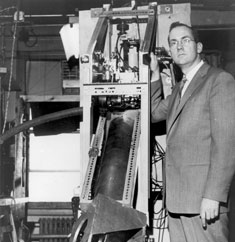Lasers
What is a laser?

Laser stands for Light Amplification by the Stimulated Emission of Radiation. It is a device that creates and amplifies a narrow, intense beam of coherent light. It is the strongest source of light ever created by man. For example, a 0.001 watt laser is about a million times more brilliant than a 100-watt light bulb.
Because laser light is very powerful, significant injuries to operators and other personnel, as well as damage to property can result if lasers are not used properly. Lasers also have the potential to be fire, electrical, biological, or chemical hazards.
The trick in generating a laser is to find the right atoms with the right internal storage mechanisms and create an environment in which they can all cooperate, giving off their light at the right time, all in the same direction.
How was it invented?

Stimulated emission, the basis of a laser beam, was first proposed in 1917, by Albert Einstein.
In 1954, American physicist Charles Townes created a device that amplified microwaves (an invisible form of radiation). The device was called a maser, because it was Microwave Amplification by Stimulated Emission of Radiation.
In 1960 American physicist Theodore Maiman built the first working laser with a ruby rod as the active medium, with a spiral lamp as the power source. Iranian-born American physicist Ali Javan built a helium-neon laser a year later. In 1966 a liquid laser was constructed by the American physicist Peter Sorokin.
At first the laser had a few uses, but it was often referred to by scientists as a 'solution looking for a problem'. This opinion has changed today however, as lasers are amongst the most important pieces of technology in modern life.